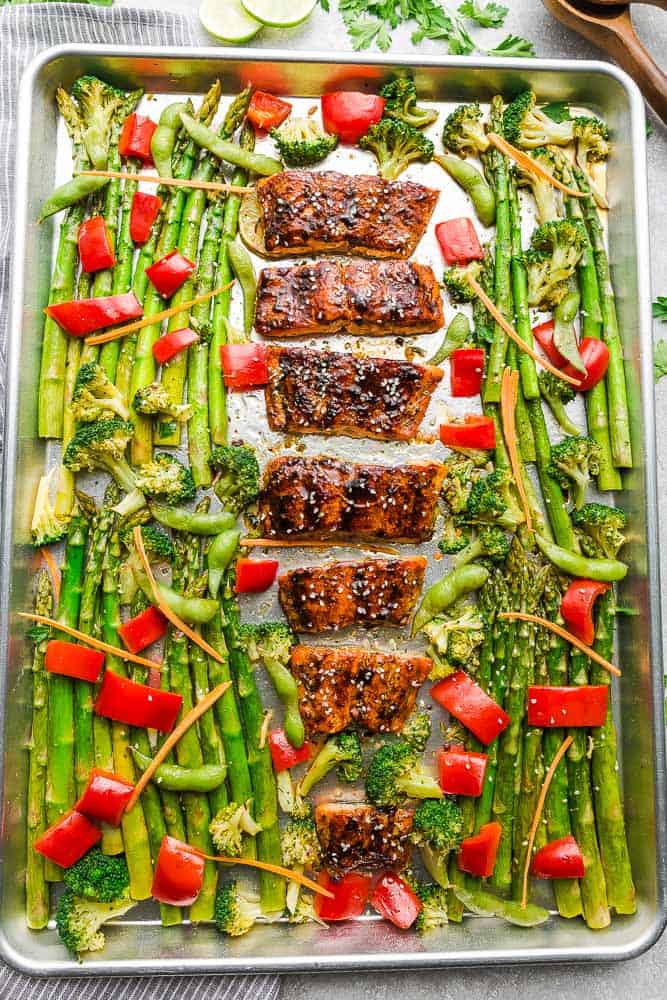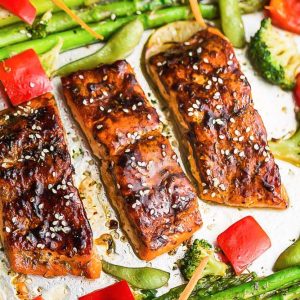This Baked Salmon is a flavorful Japanese-inspired take-out style dish combining succulent salmon fillets with a medley of vibrant vegetables and a savory teriyaki sauce.

Updated August 2023
Baked Teriyaki Salmon with Flavorful Vegetables: A Delectable Delight
Are you ready to embark on a culinary journey that will tantalize your taste buds and leave you craving for more? This Baked Teriyaki Salmon is a harmonious blend of textures and flavors featuring savory teriyaki sauce, tender salmon, and crisp vegetables. Everything cooks on one pan and comes together in around 30 minutes. It’s perfect for a quick and easy weeknight meal when you’re craving a healthy Japanese-inspired take-out style dish.
Whether you’re an aspiring chef or a seasoned cook, this sheet pan salmon recipe invites you to experiment, customize, and create a masterpiece that suits your palate. It’s gluten-free, paleo and refined sugar-free and easily low carb, keto and Whole30.
What is Teriyaki?
Teriyaki is a culinary technique and flavor profile originating from Japan that’s beloved for its exquisite blend of tastes. It involves grilling, broiling, or pan-searing ingredients—often meat or fish—after marinating them in a glaze or sauce that combines ingredients like soy sauce (or alternatives like coconut aminos), sugar, and mirin (sweet rice wine). This method creates a harmonious fusion of savory, slightly sweet, and tangy notes that coat the dish with a unique and irresistible teriyaki essence.

Ingredients You’ll Need
Before we dive into the process, let’s take a look at the star-studded lineup of ingredients that will come together to create this masterpiece:
For the Teriyaki Sauce:
- Coconut aminos: A soy-free alternative that infuses the dish with umami goodness. You can also use gluten-free tamari or low sodium soy sauce if preferred.
- Honey or sticky sweetener: Balances the savory notes with a touch of sweetness. Sub with a sugar-free sweetener such as Lakanto monk fruit or Swerve as needed. Leave out for Whole30.
- Apple cider vinegar or rice wine vinegar: Adds a tangy kick that harmonizes the flavors.
- Toasted sesame oil: Delivers a rich and nutty aroma that’s characteristic of teriyaki.
- Mirin: This optional ingredient imparts subtle sweetness, elevating the sauce’s complexity.
- Fresh garlic and grated ginger: Infuse the sauce with aromatic layers.
- Arrowroot starch: Acts as a natural thickening agent, creating a luscious glaze. You can also use tapioca starch or cornstarch.
- Water: Binds the elements together in a harmonious blend.
For the Salmon and Vegetables:
- Salmon fillets
- Assorted vegetables: broccoli florets, asparagus, julienned carrots, and optional edamame beans
- Salt and black pepper

Instructions: How to make Baked Teriyaki
Make the Homemade Teriyaki Sauce:
- Make the sauce: In a saucepan, whisk together coconut aminos, honey, vinegar, toasted sesame oil, Mirin, minced garlic, grated ginger, arrowroot starch, and water. Simmer until the sauce thickens and bubbles, then set it aside.

Salmon and Vegetables:
- Prepare for baking: Preheat your oven to 400°F and grease or line a large sheet pan with parchment paper for easier clean-up.
- Add vegetables and cook: Arrange asparagus, broccoli florets, julienned carrots, and optional edamame beans on the pan. Drizzle with toasted sesame oil and teriyaki sauce, toss to coat. Bake for 10 minutes, flip the vegetables.
- Season the salmon: Season salmon with salt and pepper, drizzle with teriyaki sauce.

- Cook the salmon: Remove the pan from the oven and add the salmon. Bake for another 12-15 minutes until salmon is tender and flaky. Drizzle with remaining teriyaki sauce.
- Serve and Enjoy: Serve the sheet pan Teriyaki Salmon with green onions and sesame seeds as garnish. Pair with cauliflower rice, jasmine rice, quinoa, or veggies for a wholesome meal.
Tips for Success: Elevating Your Culinary Experience
- Whisk and Simmer: The teriyaki sauce is the heart of this dish. When whisking the ingredients in the saucepan, ensure they’re well combined. Allow the sauce to simmer until it thickens and bubbles, releasing an irresistible aroma.
- Even Coating: To ensure every bite is packed with flavor, toss the vegetables in a drizzle of sesame oil and the teriyaki glaze. This even coating guarantees that every piece is infused with deliciousness.
Variations and Substitutions: Tailoring to Your Tastes
- Protein: Swap out the salmon for another protein of choice like our Teriyaki Chicken, Teriyaki Shrimp, Teriyaki Beef or Teriyaki Tofu for a plant-based or vegan version.
- Low Carb Twist: Opt for coconut aminos, a keto-friendly sweetener, and macadamia nut oil to make this dish low in carbohydrates.
- Veggie Delight: Embrace your creativity by substituting or adding your favorite vegetables. Bell peppers, snap peas, or even zucchini could join the party!
- Gluten-Free: Swap the soy sauce for a gluten-free alternative to make the recipe entirely gluten-free.
Serving Suggestions: A Gastronomic Adventure
Pair your Baked Teriyaki Salmon with steamed rice, quinoa, or cauliflower rice for a wholesome meal. The teriyaki glaze infuses every element with its sweet and savory goodness, making it a perfect match for various side dishes.
Storage and Freezer Instructions: Making Meals Ahead
If you’re planning to savor this dish later, here’s what you need to know:
- Storage: Store any leftover salmon and vegetables in an airtight container in the refrigerator. Consume within a day or two for the best taste and texture.
- Freezer: To freeze, individually wrap the salmon fillets and store them in a freezer-safe bag. The teriyaki sauce can be frozen separately. Thaw the components in the refrigerator before reheating.
Frequently Asked Questions (FAQ):
- Q1: Can I use a different sweetener?
- A: Yes, experiment with your preferred sweetener.
- Q2: Can I make this keto-friendly?
- A: Yes, use coconut aminos, keto sweeteners, and arrowroot starch.
- Q3: What sides go well with it?
- A: Try rice, quinoa, or greens for a balanced meal.
- Q4: Can I freeze leftovers?
- A: Wrap and freeze, then thaw and reheat.
- Q5: Can I make it gluten-free?
- A: Use gluten-free Tamari instead of soy sauce.
More salmon recipes you will love:

This Baked Salmon is a flavorful Japanese-inspired take-out style dish combining succulent salmon fillets with a medley of vibrant vegetables and a savory teriyaki sauce.
- 1/3 cup coconut aminos can also sub gluten-free Tamari or low sodium soy sauce if not soy-free
- 4 tbsp honey or preferred sticky liquid sweetener (can also use a sugar-free sweetener, such as liquid monk fruit or Swerve for keto and adjust amounts according to taste). Leave out for Whole30 or try adding 2 tbsp orange juice.
- 3 tbsp apple cider vinegar or 5 tbsp rice wine vinegar
- 2 tsp toasted sesame oil plus more for drizzling on vegetables
- 1 teaspoon Mirin sweet Japanese rice wine optional, can leave out if preferred
- 3 garlic cloves minced
- 3/4 teaspoon grated or ground ginger
- 1/2 Tablespoon arrowroot starch can also sub with tapioca starch or cornstarch
- 4 Tablespoons water
- salt and black pepper to taste
- 20 oz salmon fillets 4 fillets 5 oz each, skinless
- 1 cup broccoli florets
- 12 spears asparagus ends trimmed
- 1/3 cup julienned carrots leave out for keto
- 1/4 cup edamame beans optional - leave out if preferred
- Green onions and sesame seeds for garnish optional - leave out for keto
In a medium saucepan over medium heat, whisk together coconut aminos, honey, vinegar, sesame oil, Mirin, garlic, ginger, arrowrootstarch, and water until combined. Bring to a simmer, stirring frequently, until sauce thickens and bubbles. Remove from heat and set aside.
- Preheat oven to 400°F. Lightly coat a large sheet pan with cooking spray or for easier clean-up - line pan with parchment paper or foil, set aside.
Arrange the asparagus, broccoli florets, carrots, edamame in a single layer on the sheet pan. Season with black pepper and drizzle with 1/4 teaspoon of sesame oil and teriyaki glaze and toss to coat.
Bake in preheated for 10 minutes. Remove pan from the oven, flip and push the vegetables to the side. Arrange the salmon fillets in the middle of the pan. Season salmon with salt and black pepper then drizzle 1-2 spoonfuls of the reserved over each piece, coating well. Reserve more sauce for drizzling later.
Return pan back to the oven and cook for another 12-15 minutes (this depends on the size of your salmon) or until tender and flaky and vegetables are done to your liking. (increase cooking times if you prefer your vegetables more tender).
Remove pan from oven and drizzle with remaining sauce. Serve over your favorite sides and garnish with green onions and sesame seeds, if desired.



 Did you try this recipe?
Did you try this recipe?






Leave a Comment